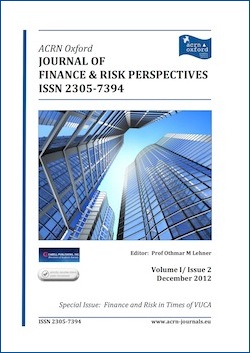ACRN Journal of Finance and Risk Perspectives
Vol. 3, Issue 1, Feb. 2014, ISSN 2305-7394

Susanne Leitner-Hanetseder 1, Markus Stockinger 1
1 Department of Accounting and Auditing, Johannes Kepler University Linz, Austria
Keywords: IFRS 11, joint arrangements, joint ventures, proportionate consolidation method, equity method, materiality, effect analysisAbstract. Following the adoption of IFRS 11 “Joint Arrangements”, IFRS-reporting entities are facing new challenges regarding the classification and accounting of joint ventures. As a consequence of the short-term convergence project between the IASB and the FASB, the accounting option for joint ventures has been eliminated in the new standard in order to reduce the differences between these two major accounting principles. However, the abolition of the accounting option for joint ventures will affect financial statement figures and key financial ratios, as some European companies have to change from the proportionate consolidation method to the equity method. This paper examines how the transition from the proportionate consolidation method to the equity method will affect European companies. It describes the relevance and preferred accounting methods for joint venture investments and explores whether the effects on several financial statement figures and key financial ratios are material for European companies. Thus, this paper provides European companies as well as the users of financial statements – auditors, financial analysts, banks and investors – first evidence of these expected effects.
1 Christian Kamtchueng
1 CTK.corp, London,UK, www.cityquant.com, ESSEC
Abstract. After the Lehman Brothers default and the Euro Crisis, funding became a major issue in the industry. The fear of default was a major concern. CVA as the collateralisation of derivatives became a standard. In this stressed context, liquidity and funding turned into a huge management issue for market participants. Funding risk, which used to be the concern only of the treasury, was pushed to the trading desk. The industry has not yet clarified a standard practice regarding funding risk. The adding of this as a charge has been the subject of intense debate. Two main points of view have emerged: one that champions the inelastic assumption (fixed funding rate), and another that does the same for the elastic assumption (funding rate adjusted immediately after each transaction). The definition of FVA is controversial, and not yet clarified. The literature is not well supplied with discourse about the actual mathematical definition of FVA. We can refer to [11], [12] and [13], but we prefer to define the term ourselves, and to present other points of view. To this effect, we present a valuation hedging methodology derived from various cases. More than CVA, FVA relates to hedging strategies. As Kamtchueng [4], Piterbarg [7] and Burgard et al. [9] note, the hedging portfolio can also provide some cash. We can end up with different sources of funding. Piterbarg [7] has developed a PDE that takes into account the derivative seller’s funding spread. Its results are based on the use of risky asset as collateral, which allows for cheaper funding than that available from the treasury. The nature of the hedging security matters. Indeed, some of them can provide cash flow, and should therefore be considered also as a source of funding. But in practice, its is more a netting effect than a proper funding source. Indeed, if our hedging securities provide us with cash flows, our hedge sellers should charge us for the funding costs they generate. Our main results are the following: First, we advance our default risk definition of FVA. Then we describe the impact of hedging strategy on the value and computation of FVA. FVA is a function of our funding spread, and in some cases, a function of hedge-seller funding.
Keywords: risk, crisis, FVA, hedging
Nesrin Benhayoun 1, Ikram Chairi 1, Amina El Gonnouni 1, Abdelouahid Lyhyaoui 1
1 Laboratory of Innovative Technologies, Abdelmaklek Essaadi University, Tangier 90000, Morocco
Keywords: Islamic Finance, Ethical Finance, Challenge, Financial crisis, Support Vector Machine, Linear Regression Model.Abstract. The last decade has seen an unprecedented growth in the practice of Islamic banking and finance which has now been recognized as a viable alternative and hopefully it will be the only financial system needed to get out from the current crisis, with the expectation that it will play an increasingly more important role in the years to come; as such, the appeal of this type of finance stems mainly from its underlying fundamental concept of justice as well as from the sharing of risk and prohibition of interest. We intend in this paper to examine the practice of Islamic Finance and its impact on the financial health of companies. Given that a company forms a micro financial system, its good financial health contributes to building a powerful economic engine; this is why we have a greater focus on companies’ financial situation, especially the company's debt situation.Therefore, we have, over 3 years (2009-2011), selected a sample of 20 firms with considerable conventional bank loans. We have also extracted about 40 financial indicators impacting their debt situation in order to set up an intelligent financial solution to measure the impact of interest on the firm’s solvency.Using Linear regression Model and Support Vector Machine Model (SVM), we have proved the high-impact of interest loans on the financial behavior of companies, and we have concluded through our SVM prediction model that interest loans can highly increase unexpected financial crises.